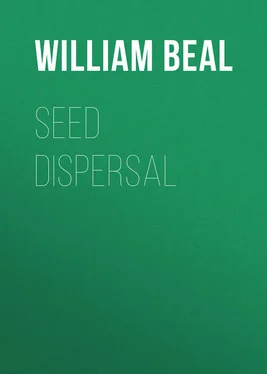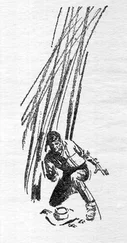William Beal - Seed Dispersal
Здесь есть возможность читать онлайн «William Beal - Seed Dispersal» — ознакомительный отрывок электронной книги совершенно бесплатно, а после прочтения отрывка купить полную версию. В некоторых случаях можно слушать аудио, скачать через торрент в формате fb2 и присутствует краткое содержание. Жанр: foreign_antique, foreign_prose, на английском языке. Описание произведения, (предисловие) а так же отзывы посетителей доступны на портале библиотеки ЛибКат.
- Название:Seed Dispersal
- Автор:
- Жанр:
- Год:неизвестен
- ISBN:нет данных
- Рейтинг книги:5 / 5. Голосов: 1
-
Избранное:Добавить в избранное
- Отзывы:
-
Ваша оценка:
- 100
- 1
- 2
- 3
- 4
- 5
Seed Dispersal: краткое содержание, описание и аннотация
Предлагаем к чтению аннотацию, описание, краткое содержание или предисловие (зависит от того, что написал сам автор книги «Seed Dispersal»). Если вы не нашли необходимую информацию о книге — напишите в комментариях, мы постараемся отыскать её.
Seed Dispersal — читать онлайн ознакомительный отрывок
Ниже представлен текст книги, разбитый по страницам. Система сохранения места последней прочитанной страницы, позволяет с удобством читать онлайн бесплатно книгу «Seed Dispersal», без необходимости каждый раз заново искать на чём Вы остановились. Поставьте закладку, и сможете в любой момент перейти на страницу, на которой закончили чтение.
Интервал:
Закладка:
10. Living branches snap off and are carried by water or wind. —Some trees and shrubs among the willows are called snap-willows, because their branches are very brittle; on the least strain from wind, rain, sleet, or snow, the smaller branches snap off near the larger branches or the main trunk, and fall to the ground. At first thought this brittleness of the wood might seem to be a serious defect in the structure of the tree or shrub, although they seem to produce branches enough for their own use.
But the branches which are strewn all around after a storm often take root in the low ground where they fall; some of them are carried down stream by the current, and, lodging on the shore below, produce new trees or bushes. During the winter of 1895 and 1896 a group of seven white willows, near a brook on the campus of the Michigan Agricultural College, was at one time loaded with sleet. There was considerable snow on the ground, which, of course, was covered with an icy crust. In a little while the sleet melted from the fallen branches strewn about, and a moderate breeze then drifted the smallest of the twigs in considerable numbers over the icy snow. Some of these were found thirty rods distant from the parent trees – not down stream in the valley of the brook, but up the stream. Had not the low ground been covered with a dense growth of grass, some of these branches might have started new trees where the wind had left them. 1 1 C. D. Lippincott believes that this is a provision of nature to dispose of the now unnecessary branchlets without leaving a knot. Plant World , Vol. I, p. 96.
The branches on slow-growing limbs of cottonwood and large-toothed aspen are much enlarged at the nodes, and at these places are brittle, often separating from the tree and breaking up into pieces. Under a small cottonwood were picked up a bushel or more of such limbs, all yet alive. These trees are common on low land, and, like snap-willows, the severed twigs may find a chance to grow on moist soil. 2 2 The brittle branches of salix were noticed by the author in Bull. Torr. Bot. Club , Vol. IX (1883), p. 89.
In a greenhouse a potted plant of Selaginella emiliana (?) was placed on the bench near the aisle, where it was often brushed by people in passing. Small branches, not being firmly attached, were frequently broken from the main plant and fell upon the moist sand, where they rooted in abundance.
CHAPTER IV
WATER TRANSPORTATION OF PLANTS
11. Some green buds and leaves float on water. —Loosely floating on slow streams of the northern states, in water not the purest, may often be found the common bladderwort, Utricularia vulgaris , producing in summer a few yellow flowers on each stem, rising from six to twelve inches above the water. The lax, leafy branches in the water are from six inches to a foot long. The leaves, or thread-like branches, are about half an inch long, more or less, and several times divided.
Scattered about are large numbers of flattened scales, or bladders, sometimes one-sixth of an inch long, which give the plant one of its names. For a long time the bladders were thought to serve merely as life-preservers; it was supposed that they were constructed to keep the plant from sinking to the bottom. In reality these bladders help preserve the plant in another sense, by catching and killing large numbers of minute animals, on which the plant lives in part. The tips of the stems at all times of the year are rather compact, made up of young leaves and stems, and in the middle of the summer, as well as at other times, many may be seen severed from the parent plant, floating in the water, ready to accept the assistance of any favorable current or breeze and start out for homes of their own to found new colonies. These olive-green tips, or buds, vary much in size, but the largest are the size of the end of one's little finger. Late in autumn or early winter, when cold threatens, the tender buds contract a little, and, having thus become heavier than water, slowly go to the bottom to spend the winter safely protected in the soft mud. All the plant perishes except these buds. With the lengthening days of spring the melting ice disappears, and genial sunshine gives notice to the dormant buds that it is safe to come out again. The buds begin to expand, become lighter than water, and are soon seen spreading out at the surface and producing branches and leaves. Ducks and other water-fowl not infrequently carry some of these wet buds sticking to their feathers or legs.
In this connection the following plants may be examined from time to time: Lemna , Wolffia , Anacharis ( Elodea ), Myriophyllum , Cabomba , and several species of Potamogeton . I have seen the leaves of lake cress, Nasturtium lacustre , often spontaneously separate from the stem, possibly carrying at the base the rudiments of a small bud, which draws on the floating leaf for nourishment and produces a small plant near its base. These plants, floated and nourished by the mother leaf, may drift down a creek or across a pond and establish new settlements. In a similar manner behave leaves of the following, and perhaps others: Cardamine pratensis , horse-radish, celandine, some water lilies, and other plants not grown in wet land.
Gardeners often propagate certain species by placing leaves on wet sand or mud, when buds spring from the margins of the leaves or from some other portion.
One of the buttercups, Ranunculus multifidus , and very likely others, spread over the mud by producing runners, much after the manner of a strawberry plant. If, as in case of a freshet, the plants should be covered with water, they show their enterprise by taking advantage of the "tide"; some of the runners are quickly severed, and are then at liberty to go as they please.
12. Fleshy buds drop off and sprout in the mud. —One of the loosestrifes, Lysimachia stricta , a plant growing in bogs, besides reproducing itself by rootstocks and seeds, bears fleshy buds half an inch long, which separate from the stems and take root in the mud near the parent plant, or often float to another spot. The buds on the stems of Cicuta bulbifera develop into small bulbs, which readily separate from the plant. They then float on the water and produce new plants. The tiger lily also produces bulblets, which scatter about and promptly take root. Every person of good understanding must have heard or read about seeds carried by ocean currents or transported by lake, pond, creek, or by muddy current, during, and after, a shower of rain; in most of these the wind is also a prominent factor. Many seeds and fruits, in some cases parts, and even the whole, of plants seem to be purposely designed for this mode of travel, while an innumerable host of others occasionally make use of it, although it may seem from their structure and place of growth that they were made especially to be transported by the wind or by some animal. As has been seen in examples previously mentioned, one portion of a plant is transported in one way, and another portion by one or two other methods.
13. Seeds and fruits as boats and rafts. —An excellent place in which to begin investigating this part of the subject is to pay a visit to the flats of a creek or river late in autumn or in the spring, after the water has retired to its narrow channel, and examine piece after piece of the rubbish that has been lodged here and there against a knoll or some willows, a patch of rushes or dead grass. We are studying the different modes by which plants travel. In the driftwood may be found dry fruits of the bladder nut, brown and light, an inch and a half in diameter. See how tough they are; they seem to be perfectly tight, and even if one happens to have a hole punched in its side, there are probably two cells that are still tight, for there are three in all. Within are a few seeds, hard and smooth. Why are they so hard? Will it not be difficult for such seeds to get moist enough and soft enough to enable them to germinate? The hard coats enable the seeds to remain uninjured for a long time in the water, in case one or two cells of the papery pods are broken open; and after the tough pod has decayed and the seeds have sunken to the moist earth among the sticks and dead leaves, they can have all the time they need for the slow decay of their armor. Sooner or later a tiny plant is likely to appear and produce a beautiful bush. Engineers are boasting of their steel ships as safe and not likely to sink, because there are several compartments each in itself water-tight. In case of accident to one or two chambers, the one or two remaining tight will still float the whole and save the passengers.
Читать дальшеИнтервал:
Закладка:
Похожие книги на «Seed Dispersal»
Представляем Вашему вниманию похожие книги на «Seed Dispersal» списком для выбора. Мы отобрали схожую по названию и смыслу литературу в надежде предоставить читателям больше вариантов отыскать новые, интересные, ещё непрочитанные произведения.
Обсуждение, отзывы о книге «Seed Dispersal» и просто собственные мнения читателей. Оставьте ваши комментарии, напишите, что Вы думаете о произведении, его смысле или главных героях. Укажите что конкретно понравилось, а что нет, и почему Вы так считаете.












